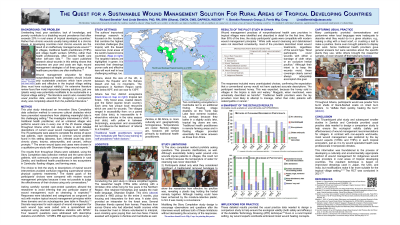Practice Innovations
(PI-003) The Quest for a Sustainable Wound Management Solution for Rural Areas of Tropical Developing Countries
Friday, May 2, 2025
7:45 PM - 8:45 PM East Coast USA Time

Richard Benskin, Not applicable – Research Associate, Benskin Research Group
Introduction:
Background: A warm climate, poor sanitation, lack of knowledge, and poverty contribute to a disabling wound prevalence that often exceeds 20% in rural areas of tropical developing countries. In this environment, wounds of all types are usually poorly managed at very high cost. Traditional health practitioners and village health workers, rather than health professionals, provide health care in most villages.
Problem: Wound management education for these lay health providers should include only sustainable practices which have proven safe and effective in the tropical village setting (they must have ecological validity). An extensive review of the literature found only a few moist improvised dressing solutions, such as a plastic wrap technique which was used on pressure injuries in Japan. No wound coverings which could be sustainable in the tropical village setting were described. Usual practice data in this setting, essential for designing a comparison study, was also completely absent from the published literature.
Methods: An innovative “story completion” data collection method overcame cultural obstacles which have prevented researchers from obtaining meaningful quantitative data in this challenging setting.
Village health workers, untrained villagers who perform self-care, and traditional health practitioners ranging from herbalists with Red Cross training to self-proclaimed witch doctors, from a variety of ecosystems and cultures in villages in Ghana, Zambia, and Cambodia, were interviewed to obtain detailed descriptions of their current usual topical wound management.
Results: Wound management practices of nonprofessional health care providers were identified in detail and quantified for the first time. In contrast with untrained villagers, the “wound expert” participants usually revealed a preference for moist treatments, such as bandages or occlusive herbal poultices, regardless of wound type. These experts expressed frustration, because often they cannot meet their goal of reliably providing a moist wound environment. Safe wound cleansing and debridement were described less consistently.
Discussion: These detailed results provided the usual practice data needed to design a comparison study to help ensure the ecological validity (both safety and efficacy) of the Available Technology Dressing (ATD) technique. The data was conclusive: moist wound management is desirable, even in the tropics. The ATD technique is loosely based on improvised dressings from Japan and India, with major modifications make it suitable for the tropical village setting. The RCT was conducted in 2021. The Available Technology Dressing technique has proven useful for a wide variety of wound types and settings.
Background: A warm climate, poor sanitation, lack of knowledge, and poverty contribute to a disabling wound prevalence that often exceeds 20% in rural areas of tropical developing countries. In this environment, wounds of all types are usually poorly managed at very high cost. Traditional health practitioners and village health workers, rather than health professionals, provide health care in most villages.
Problem: Wound management education for these lay health providers should include only sustainable practices which have proven safe and effective in the tropical village setting (they must have ecological validity). An extensive review of the literature found only a few moist improvised dressing solutions, such as a plastic wrap technique which was used on pressure injuries in Japan. No wound coverings which could be sustainable in the tropical village setting were described. Usual practice data in this setting, essential for designing a comparison study, was also completely absent from the published literature.
Methods: An innovative “story completion” data collection method overcame cultural obstacles which have prevented researchers from obtaining meaningful quantitative data in this challenging setting.
Village health workers, untrained villagers who perform self-care, and traditional health practitioners ranging from herbalists with Red Cross training to self-proclaimed witch doctors, from a variety of ecosystems and cultures in villages in Ghana, Zambia, and Cambodia, were interviewed to obtain detailed descriptions of their current usual topical wound management.
Results: Wound management practices of nonprofessional health care providers were identified in detail and quantified for the first time. In contrast with untrained villagers, the “wound expert” participants usually revealed a preference for moist treatments, such as bandages or occlusive herbal poultices, regardless of wound type. These experts expressed frustration, because often they cannot meet their goal of reliably providing a moist wound environment. Safe wound cleansing and debridement were described less consistently.
Discussion: These detailed results provided the usual practice data needed to design a comparison study to help ensure the ecological validity (both safety and efficacy) of the Available Technology Dressing (ATD) technique. The data was conclusive: moist wound management is desirable, even in the tropics. The ATD technique is loosely based on improvised dressings from Japan and India, with major modifications make it suitable for the tropical village setting. The RCT was conducted in 2021. The Available Technology Dressing technique has proven useful for a wide variety of wound types and settings.

.jpg)